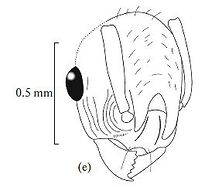Fallomyrma marginata
| †Fallomyrma marginata Temporal range: Priabonian, Late Eocene Rovno amber, Ukraine | |
|---|---|

| |
| Scientific classification | |
| Kingdom: | Animalia |
| Phylum: | Arthropoda |
| Class: | Insecta |
| Order: | Hymenoptera |
| Family: | Formicidae |
| Subfamily: | Myrmicinae |
| Genus: | Fallomyrma |
| Species: | †F. marginata |
| Binomial name | |
| †Fallomyrma marginata Radchenko & Dlussky, 2018 | |
Identification
Radchenko & Dlussky (2018) - Fallomyrma marginata differs from all known species of Fallomyrma in the presence of longitudinal carinae delineating laterally the dorsal surface of the propodeum. Additionally, it differs from Fallomyrma anodonta in the presence of short pointed teeth on the propodeum, from F. transversa in the absence of transversal rugosity on the propodeal dorsum, from Fallomyrma robusta in the more slender body and the distinctly longer head (CI = 1.20 versus 0.96).
Distribution
This taxon was described from Rovno amber, Baltic Sea region, Europe (Priabonian, Late Eocene).
Castes
Worker
Radchenko & Dlussky, 2018. Figure 1d-f. Holotype worker.
Nomenclature
The following information is derived from Barry Bolton's Online Catalogue of the Ants of the World.
- †marginata. †Fallomyrma marginata Radchenko & Dlussky, 2018: 160, plate 5, figs. 1, 2 (w.) UKRAINE (Rovno Amber).
Unless otherwise noted the text for the remainder of this section is reported from the publication that includes the original description.
Description
Worker
Body length, 3.3–3.5 mm. The head is elongated oval, with slightly convex lateral sides and occipital margin and narrowly rounded occipital corners. The masticatory margin of the mandibles has six teeth.
The mesosoma is rather short; the promesonotum is arched convex; metanotal groove is deep, abrupt, and rather wide; the propodeum has short pointed teeth. The dorsal surface of the propodeum is delineated laterally by distinct longitudinal carinae. The petiole has a long peduncle, its node is high, but somewhat shorter than the petiole length. The postpetiole is globular, somewhat longer than high.
The body is smooth and shiny; only the genae, lower part of the mesopleurae, and propodeum sides have short longitudinal, slightly sinuous rugae. The mesosoma, waist, occipital head margin, and gaster have long suberect setae, which are especially abundant on the gaster. The legs and antennal scape lack standing setae (decumbent pubescence is also invisible).
Type Material
Ho l o t y p e. Institute of Zoology of the Ukranian National Academy of Sciences, no. K–24251, worker; Rovno amber, Late Eocene. Paratype IZShK, K‒28–o, worker; Rovno amber, Late Eocene. (Dlussky and Radchenko, 2006a previously considered this specimen to be a paratype of F. transversa).
Etymology
From the Latin margino (to border), meaning the presence of longitudinal lateral carinae on the upper surface of the propodeum.


